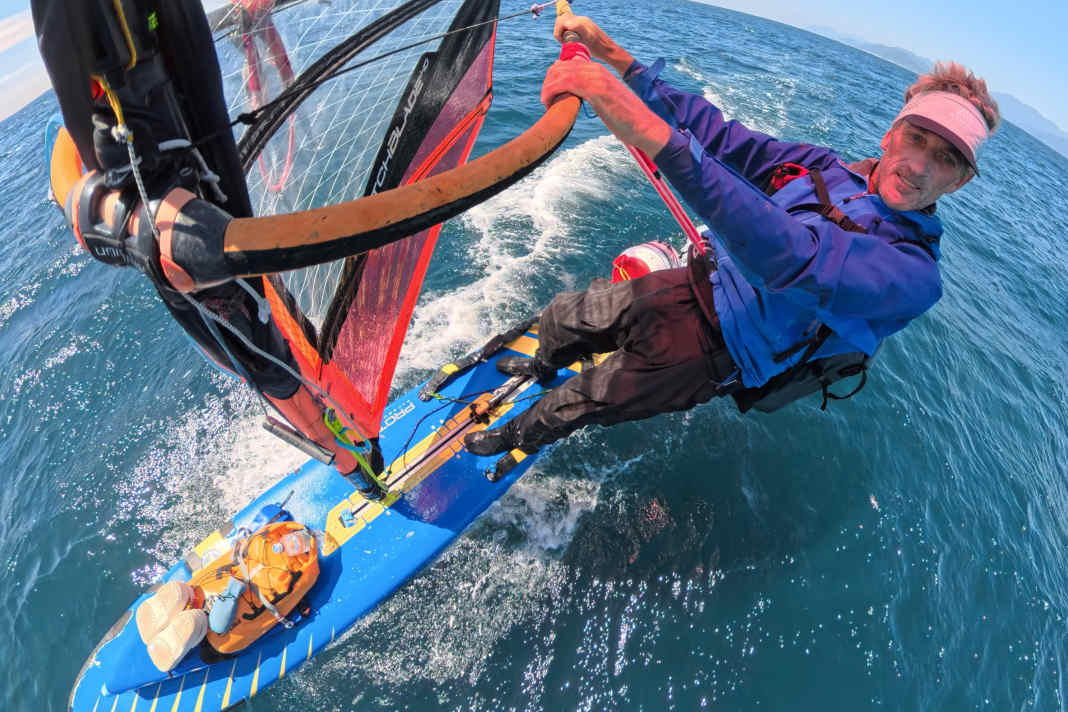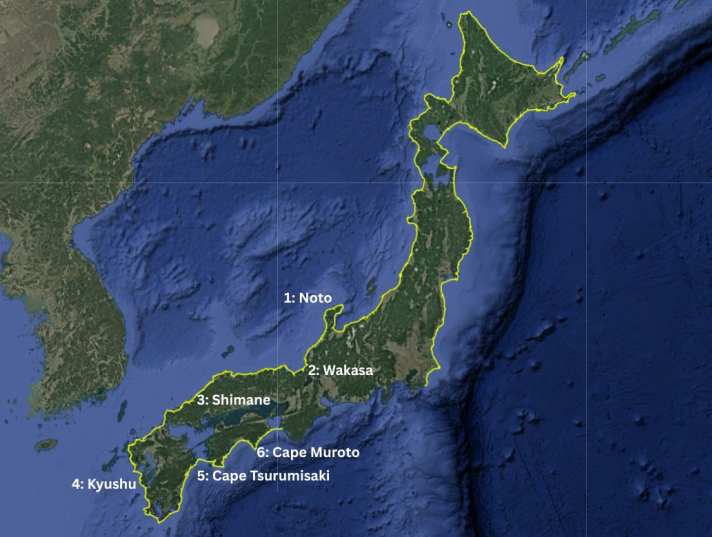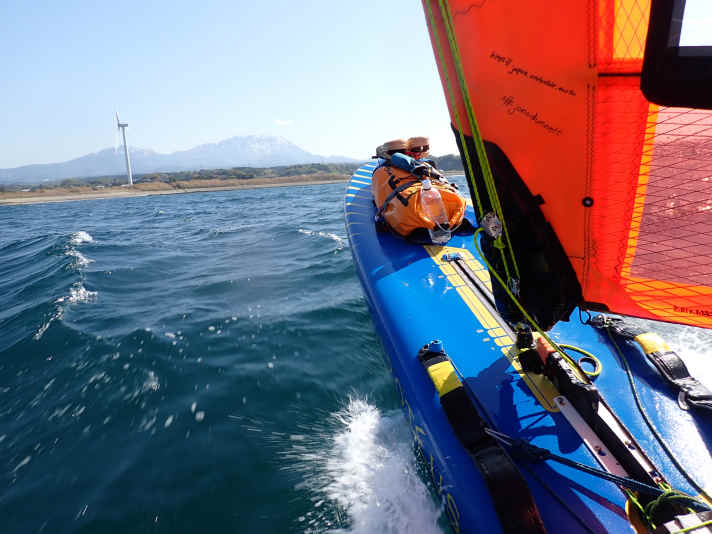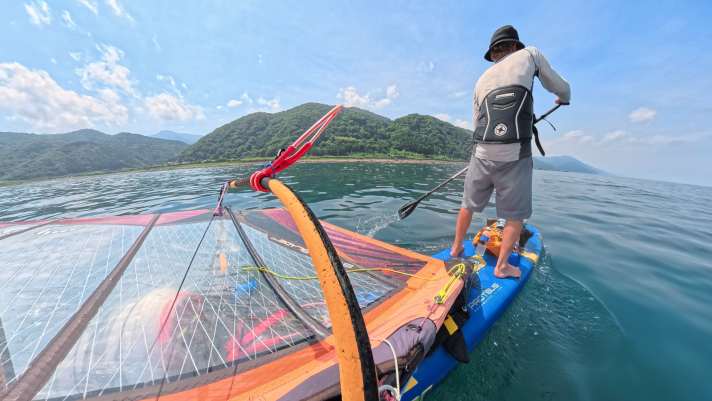Windsurf Round Japan: Heat, sharks and an ultimatum - Jono Dunnett has the finish line in sight






What has happened so far:
I wrote my last update for surf magazine on 17 March from Niigata-ken on the east coast of Japan. That was a time when the sea was cold, never flat and always uninviting. At a rough approximation, I was halfway round Japan. I had my girlfriend Yumiko as land support, which made the logistics easier: I could travel light and didn’t need to plan my stops to be within hiking distance of a konbini (small Japanese supermarket, editor's note). Our team spirit was also fantastic for morale when the weather was sometimes bleak.

Earthquakes have changed the coastline from the ground up
A particularly memorable section from that coast was the Noto Peninsula (1). For weeks, I had been looking forward to the protection afforded by this outcrop. As I sailed the calm side of the headland, I noticed that nothing was standing straight: houses, trees, and posts for electricity lines were all at crooked angles. Within a couple of days, I was back on an exposed coast, with a rocky shoreline backed by steep terrain. I had several small ports marked on my navigation app as possible landing locations, but as I approached each of these I saw only whitewater and no safe way to reach shore. Fortunately, I had sufficient wind and daylight to continue until a much larger port. There, I did find a viable landing but not the deep water port entrance I had expected. In fact, the entire port was dry. At first, I thought that the port had silted up from a landslide. It took a while, and some research, to understand that this whole coastline had jumped upwards by about 4 metres during an earthquake on January 1, 2024.
The entire coastline had jumped upwards by around 4 metres during an earthquake.
In this area, collapsed buildings and destroyed infrastructure are everywhere. The old coastal road is broken and discarded, and a new road has been hastily built upon the uplifted seabed. Minor roads where the tarmac has collapsed are simply abandoned, though Google Maps still calculates routes where a vehicle would plunge into a ravine. The death toll from the earthquake is over 600 people, though thousands more were made homeless. The dry fishing ports - of course - will never land another fish. Noto will stay in our thoughts and memories.
Going upwind against wind and current
Another section – Wakasa Bay (2) – had a series of pseudo fjords – deep inlets bound by steep and wild peninsulas. From my point of view, a mile from the coast, Japan is a country covered by dense forest. Every day I sail past an incomprehensible number of trees. Beyond here, it is time for Yumiko to let me go solo for a while. She has a job lined up at a ryokan (guest house), but will join me again later. Her support has already given me a head start on progress this season.
Rarely can I name the locations where I stop."
Rarely can I name the locations where I stop, but I try to at least know the prefecture (area or county). Some of the best sailing of the journey happened in Shimane Prefecture (3) which extends down to the southwest tip of Honshu. It was all upwind sailing, and against the current, but in a stiff breeze the board could show its pace. On occasion, a genuinely strong wind would arrive, and there would be a real fight to get back to land.

Only 90 days left - the clock is ticking
The crossing from Honshu to Kyushu (4) – Japan’s third-largest island – was barely noted as I enjoyed a clean wind to bypass the narrow and highly industrialised strait area. Much of northwest Kyushu is relatively flat, which made the sailing conditions here something of a holiday. There were also many more islands to thread a route through, and much more tidal current than in the rest of Japan. The water was also warming up, and the forests were taking on a more tropical feel. I became wary of snakes and even saw a monkey. The heat and rain were becoming difficult to live with, and though I made improvements to my bivvy bag sleeping arrangements, I was sleep deprived.
The heat and rain were becoming difficult to live with, and I was sleep deprived."
My Japan tourist visa needed a refresh, so in late May I boarded bullet train to Fukuoka and took a short flight to Seoul. Two days later, I returned to Japan and was pulled aside by immigration officers. They were unhappy about my repeat visa runs and required me to sign a statement saying that this was my last 90 days in Japan. With the ink still wet, I hot-footed it back to the board, where Amazon Prime had delivered a tent. I slept well that night, and the clock was now ticking to get round the rest of Japan.
Island number four, a personal milestone
It was now officially rainy season. Occasional very torrential downpours gave way to days on end when a fog sat over the hills and blocked all the wind close to shore. The east side of Kyushu also has a coastline with many ins and outs, and there were some notably uncomfortable paddles on a lumpy but windless sea as I made progress to Cape Tsurumisaki (5), from where I crossed to Shikoku – island number four of the quartet to be circumnavigated.
The crossing to Shikoku was emotionally significant as a personal achievement and as an indicator of progress made, and I celebrated it with a “Local Contact” Irish expat. A journey becomes more culturally rich through meeting people. It can be a lonely experience when travelling alone.

Calm, heat and circling sharks
Shikoku had almost no wind with the exception of one day. Every day involved some paddling, and many days were paddled from beginning to end. The rain was less frequent than feared, and searing heat became a new challenge. Yumiko finished her stint working at the ryokan and came straight over to find me. Her support has been a massive help in such conditions. Cape Muroto (6) was a notably nervy landmark, with strong currents and many circling hammerhead sharks just metres from the board.
Yesterday I made the crossing from Shikoku to Honshu. The first seven miles were paddled on a glassy sea. Then, fortunately, some wind arrived to help me cross the busy shipping lanes and reach the other side in daylight. Typhoon season is due next, so I have to keep pushing when conditions allow, but it seems that we are on schedule to close the loop of the journey in the time that I have remaining.
Follow Jono Dunnett in the live tracker
At this point, you will find external content that complements the article. You can display and hide it with a click.
More exciting topics about touring surfing:

